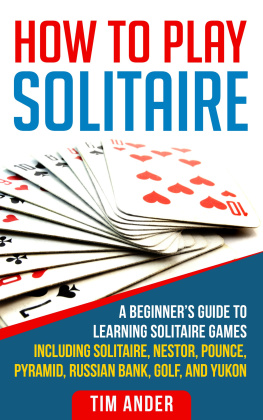LADY CADOGAN'S
Illustrated Games of Solitaire or Patience
NEW REVISED EDITION
INCLUDING
American Games
"How poor are they that have not patience." Othello .
Patientia vincit.
Printer's logo
PHILADELPHIA
DAVID McKAY COMPANY
Washington Square
Copyright, 1914, by
David McKay Company
Printed in United States of America
CONTENTS
EXPLANATION OF THE TABLEAUX
The blank spaces show where the foundation cards should be played during the deal.
EXPLANATION OF TERMS
Available cards. Those that are not "blocked" by other cards, i.e., not forbidden by the particular rules of each game, to be used.
Released cards. Those which, by the removal of the cards that blocked them, have now become available.
Suitable cards. Those whose value and suit fit them to be played or placed in the tableaux.
Foundation cards. Those on which the Patience is formed. These are generally aces and kings.
Marriage. The placing a card of the same suit on the next one above or below it in value. Any number may be placed on each other in this way.
Sequence. The regular succession of cards ascending from ace to king, or descending from king to ace; a sequence need not be of one suit.
Value. The figures of the court cards, and the number of points of the minor ones.
Suit. Either hearts, spades, diamonds, or clubs.
Lane. An empty space in the tableau, which has been formed by the removal of an entire row of cards.
Talon. Cards which, being unsuitable at the moment, are laid aside in one or more packets till they can come into use.
To play cards. The placing them on the foundations in contradistinction to placing them elsewhere.
Re-deals. These are always in addition to the original deal.
LA BELLE LUCIE.
LA BELLE LUCIE.
LA BELLE LUCIE
One Entire Pack of Cards
RULES
- The uppermost card of each packet is alone available, until by its removal it releases the one beneath.
- The foundations must follow suit.
PLAY
Deal out the entire pack in packets of three cards dealt together and placed as in tableau. The last packet, however, will contain but one card.
The four aces form the foundation cards, and are to ascend in sequence to kings.
Having placed the tableau, take any aces that may appear on the surface of the packets and play them in their allotted spaces, and upon them any other suitable cards, subject to Rule I.
When all available cards have been played, you proceed to release others, by forming marriages in a descending line on the tableau; but great care is requisite, lest in releasing one card another still more necessary to success should be blocked. The whole tableau should be carefully examined, and the combinations arranged so as to release the greatest number of suitable cards.
When this has been done, and there are no more available cards to play, the entire tableau may be taken up, shuffled and re-dealt (if necessary twice), then played again as before.
This game can also be played with two packs, the eight aces forming the foundation cards, and double the number of packets being dealt for the tableau. It is then called " The House in the Wood ."
There is also another way of playing it with two packs. The foundation cards to be four aces, and four kings of different suits, and marriages made both in ascending and descending lines. The name of this game is " The House on the Hill ."
NAPOLEON AT ST. HELENA.
NAPOLEON AT ST. HELENA.
NAPOLEON AT ST. HELENA
Two Entire Packs of Cards
RULES
- Only cards in the lowest row are available, until a card in any other row is released by the removal of those below it, the principle being that no card can be used that has another below it.
- The foundations must follow suit.
PLAY
Deal out from left to right four rows of ten cards.
The eight aces, when they can be placed, form the foundation cards, and are to ascend in sequence to kings.
Should any aces appear in the lowest row, play them in their allotted spaces, and upon them any suitable cards to continue the foundations (Rule I).
You must now examine the tableau and endeavor by forming marriages (in descending line, and always subject to Rule I) to release other suitable cards. This, however, must be done with care, lest a sequence in a lower row may block a card above it which is much wanted, and might soon have been released.
If by these changes you can make a vacancy in the uppermost row (thus forming a perpendicular lane), it is of the greatest use. The vacancy may be refilled with any available card from the tableau or from the talon, but you are not obliged to refill it until a favorable opportunity occurs.
Note.Some players only allow the vacancy to be filled from the talon.
The card so placed has all the privileges of the original card whose place it fills, and is treated in the same manner.
When there are no more available cards to play, proceed to deal out the remainder of the pack, turning the cards one by one, playing all suitable ones on the foundations, or placing them on the sequences of the tableau. The cards that cannot be so employed are laid aside in one packet, forming the talon.
There is no re-deal.
THE FIFTEEN.
THE FIFTEEN.
THE FIFTEEN
Two Entire Packs of Cards
RULES
- Only cards in the seventh or lowest row are available, until by their removal those above them are released. No card can at any time be used that has any other below it.
- Note.There is one exception to this rule, in case the game cannot be opened. See below.
- Each foundation must follow suit.
PLAY
Deal out the entire pack from left to right in horizontal rows, fifteen cards in each, excepting the last one, which can only contain fourteen. Each row should partly cover over the preceding one; four aces and four kings form the foundation cards, the aces ascending in sequence to kings, the kings descending in sequence to aces. When the deal is complete, if any foundation cards should appear in the lowest row (Rule I), play them at once on the spaces reserved, and also any other suitable cardsthen marry, both in ascending and in descending lines, subject to Rule I; but if, after these changes, no foundation card is available, so that the patience cannot even begin, you may withdraw from the sixth row one ace and one king, if any are to be found (see note to Rule I), immediately filling the spaces so made with the cards below which had previously blocked them. If even this resource is unavailing, the patience has already failed, there being no re-deal, and no further infringement of rules allowed.
When one or more foundations are established, examine the tableau carefully, marry all available cards, and endeavor by these changes to release the greatest number of suitable cards for the foundations, and to open out one or more perpendicular lanes. These are of the greatest use; you may select any available card and place it at the top of the lane, and below it any others in sequence of the same suit, each card partly concealing the preceding one, as in the original deal.












